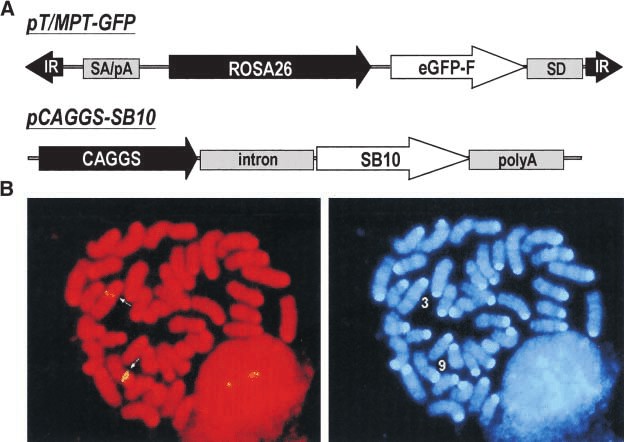Mapping of Transgenes by FISH
The mapping of transgenes by fluorescence in situ hybridization (FISH) represents a pivotal technique in molecular cytogenetics, offering unparalleled insights into the localization and organization of exogenous genetic sequences within the genomes of diverse organisms.
 Fig. 1 Transgene constructs and FISH mapping of transgene insertions. (Carlson CM, et al., 2003)
Fig. 1 Transgene constructs and FISH mapping of transgene insertions. (Carlson CM, et al., 2003)
Introduction of Transgene Mapping by FISH
Transgene mapping is a fundamental aspect of genetic engineering and biotechnology, aiming to elucidate the genomic integration sites and spatial distribution of introduced genetic sequences, such as transgenes and expression cassettes. FISH, a versatile cytogenetic technique enabling the visualization of specific DNA sequences within chromosomes, has emerged as a powerful tool for transgene mapping. By leveraging FISH, researchers can accurately localize and characterize transgenes, providing critical information for evaluating their stability, copy number, and potential genotypic effects.
Techniques and Methodologies for Transgene Mapping
- Probe design and labeling. The initial step in FISH-based transgene mapping involves the design and synthesis of DNA probes targeting the transgene sequence or its flanking regions. These probes are labeled with fluorescent dyes or haptens, such as biotin or digoxigenin, which enable their visualization upon hybridization to chromosome spreads or interphase nuclei. The selection of appropriate probe sequences and labeling strategies is pivotal in ensuring specific and high-affinity binding to the target transgene loci.
- Hybridization and detection. Following probe labeling, the prepared chromosome spreads or interphase nuclei are subjected to hybridization with the labeled probes, allowing for the specific binding of the probes to their complementary sequences within the genomic DNA. This step involves stringent optimization of hybridization conditions, such as temperature, stringency, and hybridization buffer composition, to ensure robust and specific probe binding. After hybridization, the detection of the fluorescently labeled probes is achieved through microscopy, with the choice of imaging system and fluorescence filters being tailored to the spectral properties of the employed fluorophores.
- Data analysis and interpretation. Following the visualization of transgene loci by FISH, meticulous data analysis and interpretation are essential for accurate mapping and annotation of the observed signals within the chromosomes. This involves precise karyotyping of the hybridized chromosomes, identification of transgene integration sites, determination of copy number variations, and assessment of potential colocalization with endogenous genomic elements.
Transgene Mapping in Genetic Engineering and Biotechnology
Transgene mapping by FISH plays a crucial role in enhancing our understanding of transgene integration patterns and their potential impact on host genomes in the context of genetic engineering and biotechnology. By precisely mapping transgenes, researchers can assess their positional effects, influence on nearby gene expression, and potential risks of unintended genomic alterations, thereby informing the design and evaluation of transgenic organisms with improved safety and predictability.
Transgene Mapping in Biomedical Research and Disease Modeling
In biomedical research, transgene mapping by FISH contributes to the elucidation of transgenic animal models' genomic alterations and their relevance to disease modeling and preclinical studies. By mapping transgenes, researchers can ascertain their chromosomal position and potential influence on endogenous gene expression, paving the way for accurate interpretation of phenotypic outcomes and disease-relevant phenotypes in transgenic animal models.
Creative Bioarray Relevant Recommendations
| Service Types | Description |
| Transgene Mapping (FISH) | Creative Bioarray can use FISH to confirm the integration of transgenes and determine their chromosome band location. We guarantee the speed, quality, and cost of our service. |
| Transgene Mapping (Locus Amplification & Sequencing) | Creative Bioarray has developed the Transgene Mapping (Locus amplification and sequencing) analysis, which is a powerful tool to sequence transgenes and their integration sites. |
| Custom Probes | Creative Bioarray is pleased to announce the introduction of customized ISH probes for a range of molecular and cytogenetic applications. |
Reference
- Carlson CM, et al. (2003). "Transposon mutagenesis of the mouse germline." Genetics. 165 (1), 243-56.